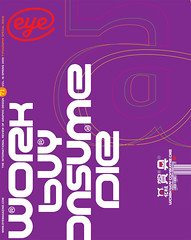Spring 2009
Editorial Eye 71
This issue of Eye, a ‘type special’, celebrates a great era for the art, craft and business of type – right now. Whether you are a type maker or user, a typographer, type designer, technologist, art director, designer or reader, there is an explosion of products and services to meet every need. Nearly every stage in the process of design, from first idea to last look, is aided by slow-burning yet revolutionary improvements in the way type is produced, distributed, rendered, printed and hinted.
Individual type designers, whether established or straight out of college, can set up shop and reach customers directly – thanks to the Web’s vast marketplace – while the bigger foundries constantly refine their work for corporate and individual clients. And a classic typeface such as Britanica (pp.46-49) can emerge, like a Modernist phoenix, from the ashes of British Rail’s nationalised past, digitised and available 24 / 7. This is a fate somewhat different to that of the hand-lettered headlines in ‘Drawn to be wild’ (pp.56-61), now rescued from obscurity by Rian Hughes.
There are more typefaces than ever before, including many that, in the words of Paul Shaw (who contributes a terrific piece on the minutiae of optical sizing, pp.62-69), evoke the ‘spirit of the past’. Such fonts may be brand new, sensitive revivals or extended superfamilies (see pp.50-55). With this in mind, Deborah Littlejohn approached a dozen art directors and designers to ask each whether the present day could be described as a ‘golden age’, and to name their current favourite typefaces (pp.38-45). Their responses, though entertainingly divergent, throw fresh light on the richness of contemporary type production.
And this is a special issue in another way: two features deal with controversial, intensely individualistic studios, whose members have sought and claimed new roles for graphic design. There’s a thoughtful profile of Amsterdam-based Metahaven (pp.22-29), whose projects are closer to a think-tank’s than those of a conventional design studio. And we feature Ian Anderson, founder of cult Sheffield studio The Designers Republic (TDR), in a ‘Reputations’ interview (pp.10-21) by Liz Farrelly, with extensive caption commentary by Anderson himself.
Spawned by a research project, Metahaven strive to find new roles – as thinkers and self-directed strategists – for graphic designers, hoping to change the possibly outmoded ‘client-studio’ model of conventional practice. Reflecting on nearly 23 years at the helm of TDR (who have legions of admirers worldwide), Anderson looks at the impact of that model – complete with account-handlers – on his practice, which he now says ‘was trying to do something it was better not being . . . when I took a back seat . . . it died.’
In January, Anderson’s company went into voluntary liquidation. He subsequently bought back the name, and has relaunched the studio with a smaller team.
Both studios have an affinity with architecture, a liking for provocative slogans, and an ‘awkwardness’ that puts them somewhere outside conventional design. The opinions and work of both studios – however different – contain many lessons for anyone aiming to rethink the role of the studio in these challenging times.
John Walters, editor, Eye, London
First published in Eye no. 71 vol. 18 2009
Eye is the world’s most beautiful and collectable graphic design journal, published quarterly for professional designers, students and anyone interested in critical, informed writing about graphic design and visual culture. It is available from all good design bookshops and online at the Eye shop, where you can buy subscriptions and single issues.

